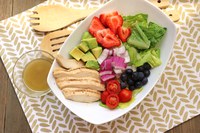Prairie Fare: 3 Key Nutrition Items to Consider as We Grow Older
(Click an image below to view a high-resolution image that can be downloaded)
By Julie Garden-Robinson, Food and Nutrition Specialist
NDSU Extension
“Wow, that’s a lot of food!” my husband commented as the server set a platter in front of me.
We were in a small-town cafe in Minnesota. I ordered the “special.” It included two heaping scoops of mashed potatoes and gravy, at least a cup of corn and enough roast beef to feed my family. A good-sized bun accompanied the meal.
My husband ordered the crispy chicken tortilla roll-up sandwich. He received an equally generous portion of two large half-sandwiches. The sandwich was accompanied by a pile of fries.
The food was homemade and delicious, by the way. If I had been going out to chop wood or throw bales of hay, I might have needed that many calories. After lunch, I was scheduled to stand and answer questions, which taxed my brain but not my muscles.
“Maybe we can take a nap in the car after we eat,” he commented. “We probably need to order small portions as we get older.”
Eating smaller portions was a good idea, actually. If the Robinsons ate this much food at every meal, we probably would need larger clothes and, perhaps, a larger vehicle.
However, my husband ate his entire sandwich and some of my roast beef. Even though I do not like to waste food, I could only eat half of the portion. If I had a cooler, I would have brought home half my food.
I thought I might be nodding off during my own talk. That’s not a good practice.
What are some of the special recommendations for food as we grow older?
The 2020 to 2025 U.S. Dietary Guidelines includes a section about eating as we grow older. I haven’t reached the “older adult” category of 60-plus, but actually, adults of any age could benefit from the lessons in these new guidelines.
The guidelines form the basis for recommendations in all the federal food programs, from child care settings to school lunch to home-delivered meals.
Here are three items from the guidelines related to healthful eating as we age.
We all need to consume enough protein so we can avoid losing lean muscle mass. By the time people reach 71, many are not consuming enough protein, according to some researchers. Try eating a variety of lean proteins such as meat, poultry, fish, eggs, beans, peas and lentils.
Most adults need about 5 to 7 “ounce equivalents” of protein per day, depending on whether we are male or female and our age and activity level. One egg; 1 ounce of meat, poultry or fish; 1/4 cup cooked beans; or 1 tablespoon of peanut butter count as an ounce equivalent.
Be sure to consume enough vitamin B-12. As we grow older, our ability to absorb this nutrient can decline. A deficiency can lead to a type of anemia that requires medical testing. It also leaves you feeling tired.
Vitamin B-12 is found in animal-based foods such as meat, milk and eggs, and also in fortified foods such as breakfast cereal. Some people may need a supplement, but discuss this with a health-care provider.
Stay hydrated with plenty of water and other healthful beverages such as 100% fruit or vegetable juice, milk or alternatives. People ages 60 and older tend to consume less fluid than younger adults because the sense of thirst tends to decrease as we age.
Fruits and vegetables also provide ample fluid. Yes, a moderate amount of coffee and tea counts toward hydration but the caffeine can promote some fluid loss. Consume water more often than caffeinated beverages.
To learn more about needs as we age, see https://www.myplate.gov/life-stages/older-adults for a variety of tips about nutrition and physical activity.
Here’s some lighter fare to enjoy during the warm summer months. You can choose your favorite protein. Many ready-to-heat grilled meats are available to ease the time involved in preparing this dish.
Summer Grilled Chicken (or Steak) Salad
2 chicken breasts (about 1 lb.), boneless and skinless (or 1 lb. steak)
Salt (to taste)
Pepper (to taste)
Salad base
4 c. chopped romaine lettuce
1 large avocado, peeled and diced
2 c. sliced strawberries
1 c. blueberries
1/4 c. red onions, chopped or sliced
1 c. cherry tomatoes, halved
Dressing
3 Tbsp. olive oil (or your favorite oil)
1 tsp. balsamic vinegar
1/2 tsp. minced garlic
1/4 tsp. Dijon mustard
2 tsp. milk
Pinch of salt and pepper
Place chicken breasts (or steak) on plate and season both sides with salt and pepper. Heat grill to medium heat (approximately 400 F). Place meat on grate over direct heat for four to five minutes each side. Move meat away from the direct heat and cook for an additional five to seven minutes or until the internal temperature of the thickest part of the chicken reads 165 F or the steak reaches 145 F. Remove from grill and let rest at least five minutes. Dice the meat and set aside. Prepare dressing by combining ingredients in small mixing bowl or Mason jar. Whisk or shake well to combine. Assemble salads by evenly dividing lettuce, avocado, strawberries, blueberries, tomatoes and onions among four plates. Add diced chicken breast. Drizzle with dressing.
Makes four servings. Using chicken and no added salt, each serving has 370 calories, 20 grams (g) fat, 29 g protein, 20 g carbohydrate, 7 g fiber and 75 milligrams sodium.
(Julie Garden-Robinson, Ph.D., R.D., L.R.D., is a North Dakota State University Extension food and nutrition specialist and professor in the Department of Health, Nutrition and Exercise Sciences. Follow her on Twitter @jgardenrobinson)
NDSU Agriculture Communication - Aug. 5, 2021
Source: Julie Garden-Robinson, 701-231-7187, julie.garden-robinson@ndsu.edu
Editor: Ellen Crawford, 701-231-5391, ellen.crawford@ndsu.edu




